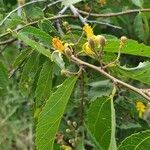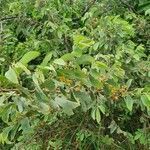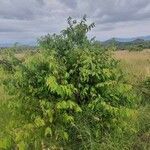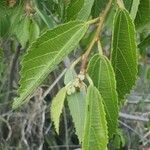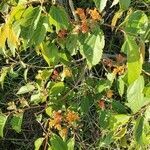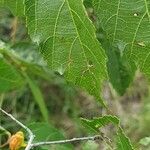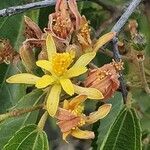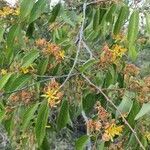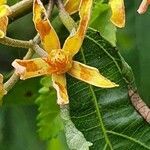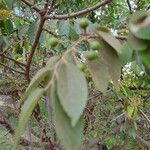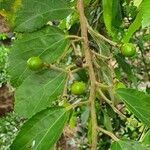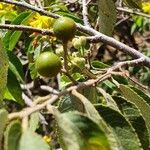Shrub or small tree to 6 m tall.. Leaves ovate to elliptic, 1.3–9.1 cm long, 0.8–4 cm wide, acute to acuminate at the apex, obliquely truncate to rounded, sometimes slightly asymmetric, at the base, margin coarsely serrate to crenate, scattered to sparsely minutely stellate-pubescent above, indumentum beneath very variable, concolorous or discolorous, ± glabrous, minutely stellate-pubescent or quite densely pubescent; petiole 2–8 mm long; stipules subulate, 6–8 mm long.. Inflorescence a (1–)3-flowered cyme, 1–3 in a leaf-axil; peduncle 4–18 mm long; pedicels 4–8 mm long.. Flowers yellow; sepals 6–9 mm long; petals oblong to ovate, 4–5 mm long, emarginate at the apex.. Androgynophore ± absent or up to 1.5 mm long, glabrous, densely hairy at the apex and produced up to 0.5 mm.. Stamens 4–6 mm long.. Ovary 1–2 mm long, densely hairy; style 4–5 mm long.. Fruit unlobed, rarely 2-lobed and then very unequally so, 4–6 mm long, 4–7 mm wide, sparsely hairy, yellow to orange.. Fig. 4/36 (leaf, p. 11).
More
An erect evergreen shrub. It grows 2-6 m high. The bark is silver-grey. The leaves are thin and papery. The leaves are narrowly oval. They are 3-11 cm long by 1-5 cm wide. The flowers are yellow. There are several flowers in a group. The fruit is orange and can have 1 or 2 lobes. It is 5-7 mm long.
Wooded grasslands and in Acacia tortilis woodlands at low to medium elevations. Sandy or rocky soils, in wooded grassland, bushland, dry forest and riverine forest at elevations from 900-2,150 metres.
More
A tropical plant. It grows in sandy soil. It grows between 600-2,150 m above sea level. It can grow in arid places. In Tanzania it grows in areas with a rainfall between 900-1,400 mm.
